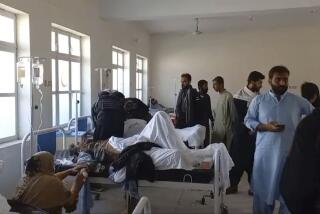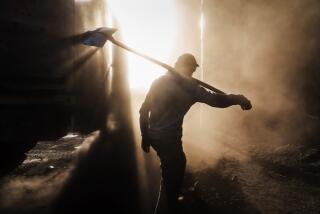Pakistan’s clashes are felt even here
- Share via
SKARDU, PAKISTAN — Psst -- don’t tell anyone, but there’s still another part of Pakistan, an oasis of striking beauty all but free of the turmoil, Taliban militancy, suicide bombers and security fears that have gripped much of the rest of the country.
Clocks here in Skardu in northern Pakistan, an hour’s flight from Islamabad, may display the same time as their counterparts in the capital, or in Lahore and Karachi. But the slow pace, tranquillity and welcoming of outsiders are more befitting of a long-gone age when traders on horseback plied the nearby Karakoram Highway.
“Someday maybe all of Pakistan will be as peaceful as this,” said Abdul Munim, 29, a businessman from Islamabad who has spent much of the last year building cellphone towers in the isolated region more than 7,000 feet above sea level. “There’s no fear, no danger of going outside, nothing but quiet.”
Residents proud of Pakistan’s rich history and stark natural beauty say foreigners should recognize that there are many parts to Pakistan, not just those making news for the wrong reasons.
“We’re a world away from those problems,” said Sharafat Hussain, owner of a climbing-equipment shop in Skardu, who was surrounded by ropes, camp stoves and oxygen bottles used by adventurers heading up nearby K2, the world’s second-highest peak. “It’s probably safer here than in America. Unfortunately, foreigners think Pakistan is nothing but Taliban and suicide bombs.”
That fear has the area’s tourism-dependent economy reeling. Guides say the number of annual climbing expeditions has dropped by half to about 60, with the biggest decline coming after security forces’ 2007 storming of Islamabad’s Red Mosque, which had been seized by militants.
Passengers landing on the Skardu airport’s bumpy runway, nestled on a plateau surrounded by snowcapped mountains, are greeted by dozens of underemployed drivers elbowing for customers. Summers are short, leaving little time to earn the tourist dollars that might have to sustain a family the rest of the year. Climbing season for the high peaks runs from late March to mid-September.
“Business has been hit and Pakistan has big problems,” said chain-smoking climbing guide Hassan Sadpara, the first Pakistani to ascend K2 without oxygen. “Foreigners should realize that we don’t have extremists up here and everyone is very nice.”
There are no direct flights to Skardu or neighboring Gilgit from abroad, so it’s still necessary to transfer through Islamabad or another of Pakistan’s cities that have seen violence recently.
Last month, a suicide bomb went off in the Pakistani-controlled portion of Kashmir, which, though some distance from here, is likely to further cut tourism in the area.
The drop in the number of foreign visitors has been made up for in small part by Pakistani honeymooners, though they don’t tend to stay as long or spend as much money.
“We came here because it’s the safest place in Pakistan,” said Abdul Malik, 32, who was having breakfast with his bride, Sadia, at the 400-year-old Shigar Fort, now a boutique hotel. “It’s very easy to relax here.”
Even as many Pakistanis acknowledge the deteriorating security environment and their own reluctance to visit cinemas and bazaars, they condemn foreign governments for issuing travel advisories they believe make Pakistan seem uniformly troubled.
“The U.S. and British governments are making big problems with these warnings,” said Hussain, the hiking gear seller.
Beyond the town, the landscape broadens out, dwarfing the one-lane road and occasional lush village of terraced fields divided by rock walls. Periodically, at a bridge or mountain pass, a police officer appears from a dusty hut with an oversized ledger that foreigners must sign if they want to pass. In some cases, the last recorded visitor, maybe a South Korean or Czech climber, passed by four days earlier.
Just past Khaplu, three hours from Skardu near the start of a trail leading to the K2 base camp, two soldiers at a checkpoint turn back all foreigners in vehicles. Further exploration of the area, a valley ringed by 10 majestic, snowy peaks, must be done on foot.
The military precautions aren’t aimed at the Taliban, a threat people here acknowledge even if they consider it inflated by Washington and London, but rather at what many Pakistanis consider the “real enemy” -- neighboring India.
The so-called Line of Control dividing Kashmir -- a region that has been the object of two wars and several near-misses between the longtime adversaries -- is just 40 miles away.
Pakistani army Maj. Majid Farooqui, who spent eight years guarding various spots along the uneasy high-altitude border, ranks the Indian and Taliban threats equally.
“Pakistan is in a tough spot, surrounded by Afghanistan, China, India,” said Farooqui, now posted in Rawalpindi but visiting Skardu to show his family the place where he served for so long. “Hopefully things will improve.”
Pakistan’s tourism agency acknowledges that the country is a tough sell, even the generally peaceful northern area.
“Since 2007, the first question everyone asks about is security,” said Taib Nasir Mir, the agency’s deputy manager.
The government spent large sums on a “Visit Pakistan” promotional campaign in 2006-07, only to have the Red Mosque crisis erupt. So it focused on domestic tourism to the Swat Valley, but the area became a battleground for Taliban militants and the army. And as it tried to market northern Pakistan to Indians, the Mumbai attack in November soured relations.
This year, Pakistan expects about 7,000 tourists, not including those coming to visit relatives. That’s roughly half the 2007 level.
Muazzam Amacha, 22, the 40th generation of a local ruling family that until recently lived in the Shigar Fort, said he saw no chance of the Taliban making its way to this part of Pakistan.
“The roads are well guarded and Afghanistan is far away,” he said.
But others point out that the Swat Valley was also a tourist haven before the militants expanded their grip, demolishing girls’ schools, killing police officers and enforcing their version of Islamic law.
“The Taliban came briefly to Gilgit,” about 90 miles away, said Sadpara, the climbing guide. “So it’s possible they could come here. God willing, it won’t. All this killing, it’s really not good.”
--
More to Read
Sign up for Essential California
The most important California stories and recommendations in your inbox every morning.
You may occasionally receive promotional content from the Los Angeles Times.










